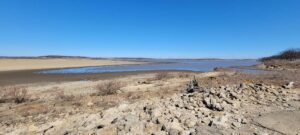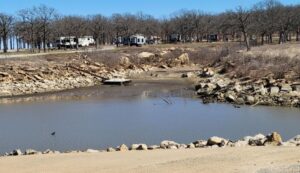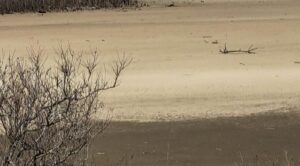Update: As of March 27, overall water supply has fallen to 61.8 percent. Water use is a reported 4.21 million gallons per day (mgd).
Water conservation remains a top priority for Bartlesville and the surrounding area as overall supply continues to decline due to drought conditions here and the Hulah Lake watershed, located in Southeast Kansas.
The City of Bartlesville issued a call for conservation in December 2022. At that time, overall supply levels had reached 71 percent. Those levels have continued to fall since then, this week hitting the lowest number in the four-month period.
The numbers
“Our overall water supply level has fallen to 62.1 percent while our water use has held steady, at 4.2 mgd (million gallons per day),” said Water Utilities Director Terry Lauritsen.
The City is currently in Phase 2 of the Drought Contingency Plan, which was created following a severe drought that occurred over the fall of 2001 into the spring of 2002.
“We are very close to entering Phase 3, which will occur when our levels hit 60 percent,” Lauritsen said. “Pending approval of the City Council in April, Phase 3 would prompt the implementation of several restrictions aimed at reducing consumption, including higher water rates, restricted outdoor watering, and the closure of City-owned splash pads.”
If levels continue to decline and the City enters the “critical” phase, or Phase 4 of the plan, outdoor watering could be eliminated altogether and swimming pools could be closed for the summer in addition to the other measures.
How did we get here?
While drought conditions are primarily to blame for the problem, it was certainly exacerbated by something that seemed, at least in 2021, mostly unrelated: the renovation of the Caney River Pump Station.
The station was taken off-line in mid-2021 for a much-needed renovation, eliminating the City’s ability to pull 4 millions of water per day from the Caney River. The shut-down was intended to take a few months, but supply chain issues caused by the pandemic wreaked havoc with that plan.
“Basically, we were unable to get an essential piece of equipment needed to operate the pump station due to supply chain issues, and that has kept the station off-line for more than a year — far longer than was anticipated,” said Lauritsen.
Without the ability to withdraw 4 mgd from the river, that water was pumped directly from Hulah Lake into the City-owned Hudson Lake, where it is then taken into and treated at the City’s water treatment plant.
This created more of a load on Hulah Lake than it was able to handle due to the drought in Kansas, Lauritsen said.
“Had the pump station been on-line and working all this time, we could have been meeting our water needs without taxing the lake, so while we would likely still be concerned about the impact the drought is having on the lake, the problem wouldn’t be as bad as it is,” he said.
The equipment that caused the delay, a motor control — the part required to start the pump and operate the system — was eventually found by the contractor working on the pump station project, Lauritsen said.
“We were a year out on every vendor we tried,” he said. “The contractor finally found one that had been purchased for another job but not used.”
Now that a motor control has been located, the pump station should be operational again by mid-April, Lauritsen said.
Copan Lake: High cost for little ROI
Some Bartlesville residents may recall that retired Sen. James Inhofe worked tirelessly to broker an agreement between the City and the U.S. Army Corps of Engineers that allows the City to purchase water rights at Copan Lake, thanks to a provision Inhofe authored in America’s Water Infrastructure Act of 2018.
The agreement had been sought since studies following the 2001-02 Bartlesville drought indicated obtaining water from Copan Lake was the City’s most feasible option for drought management into the foreseeable future.
“At the time that this option was sought, it was the most feasible option for the City to pursue,” Lauritsen said. “However, while Sen. Inhofe’s work enabled the City to obtain the last remaining water rights at Copan Lake, the agreement only gives us access to 1 million gallons of water per day from Copan Lake.
“And unfortunately, the cost to pump that 1 mgd from the lake to the water plant was about $38 million in 2014. Today’s prices would be considerably higher. Because of this, the conveyance of Copan Lake water to Bartlesville will be through the Caney River, utilizing the City’s pump station in Johnstone Park.
Water reuse: Years away
Anyone paying attention to Bartlesville water issues has certainly heard about the City’s water resuse system — a project that got off the ground a few years ago, thanks to Oklahoma’s passage of the Water for 2060 Act.
The water reuse system involves the construction and installation of infrastructure that will consist of a pump station at the wastewater treatment plant and an underground pipeline transporting the water to the Caney River just south of the County Road West 1500 bridge. This will allow the City to utilize treated wastewater to augment the yield of the Caney River during periods of drought.
“We will pump treated wastewater approximately seven miles upstream of the Caney River Raw Water Intake and allow it to blend with existing river water, then send it to the water treatment plant for further treatment and, from there, to our water customers,” Lauritsen said.
While the system is vital for the area to guard against drought in the future, it won’t be on-line in time to help with the current problem, Lauritsen said.
“This system will ensure area water needs are met at least 30 years into the future, with the potential to extend our water resources another 60-70 years, depending on demand,” Lauritsen said. “But we are still a few years away from being able to use this system to meet our water supply needs.”
Has it been this bad before?
While the situation has the potential to be dire, Bartlesville has been here before, Lauritsen said.
“We were in a very similar situation in 2012-13,” he said. “Our numbers looked very similar to this, until it rained in April and May and lake levels were restored.
“Of course, our most serious drought occurred in 2001-02, when Hulah Lake was down to 17 percent before it rained in June and July of 2002 and re-filled the lake. Thankfully, we are nowhere near that level today.”
Restrictions necessary
The City Council is expected to consider modifications to the Water Storage Ordinance and a resolution to enact the emergency water rate provisions of the Water Shortage Ordinance during its April 3 meeting, Lauritsen said.
“The ordinance modifications will better define and update measures outlined in the Drought Contingency Plan, which was written following the drought of 2002,” he said.
Lauritsen said water use can easily double — or even triple — during the summer months, which will only compound the problem. He said evaporation also contributes to the problem during the summer months.
“During the summer, we lose a little more to evaporation than we consume daily,” Lauritsen said. “So that is actually a pretty big problem during those warmer months.”
Projected outcomes
How long will the water we have left last without rain and/or serious attention to conservation efforts? It’s hard to say, but Lauritsen says that even with the pump station up and running by mid-April, the area could enter the “critical” stage for water supply in June.
“If it doesn’t rain, and if our water use climbs as it would during a typical summer, we anticipate dropping below 50 percent of water supply in June,” he said. “That 50 percent mark is what we would consider critical.”
Lauritsen says while he is hopeful that some good, old fashioned rainfall will fill the lake and resolve the issue yet again for Bartlesville, it pays to be cautious and plan carefully.
“Certainly, it could rain enough between now and June that conservation would no longer be required, but it would be better to conserve now unnecessarily than be unprepared to deal with a potentially dangerous situation later,” he said.
“Hopefully, we will begin to conserve in big enough numbers that we can have an impact on this if the worst-case scenario comes to pass. We are strongly urging everyone to do their best to conserve water as we navigate our way through this.”
Some ways you can help:
- Take shorter showers. This is the No. 1 most effective thing we can do (indoors) to conserve.
- Consider installing “low flow” plumbing, i.e., toilets, shower heads, etc. Also, replace any leaky or defective parts.
- Turn off the tap while brushing your teeth or shaving.
- Never use the toilet as a wastebasket. Only human waste and toilet paper should go into the toilet — ever.
- Run the washing machine only when full and adjust the water level setting carefully.
- Stop or reduce outdoor watering.
For more information, see www.cityofbartlesville.org.



